
Rose-Morris were an important British musical instrument distributor of the 1960s, most notably for their early association with Rickenbacker from 1964. Correctly, the company name was Rose, Morris & Co, Ltd, but their logo simply used the hyphenated Rose-Morris. They also handled (at various times) guitars by Eko, Levin, Fenton Weill, Martin, Burns, Shaftesbury, Avon, Tatay, Aria, Ovation, Ariana, Suzuki and Sigma; amps by Marshall; keyboards by Thomas Organ, Gem and Korg; and drums by Rose Morris, Shaftesbury, Slingerland, Autocrat and Broadway.
Rose-Morris were London-based, with a head quarters at Gordon House Road, North London, but on September 8th, 1967, they opened central retail showrooms at 81-83 Shaftesbury Avenue. Guitars and amplifiers on the ground floor, with wind instruments and keyboards upstairs. This was, of course, an area of London with dozens of instrument shops within a few minutes walk.
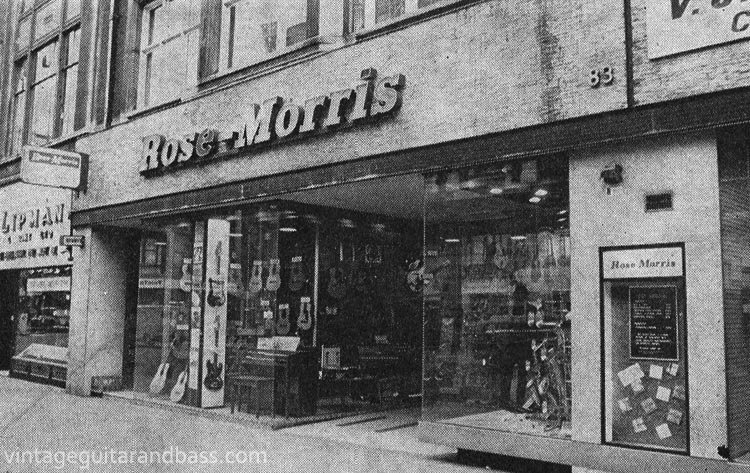
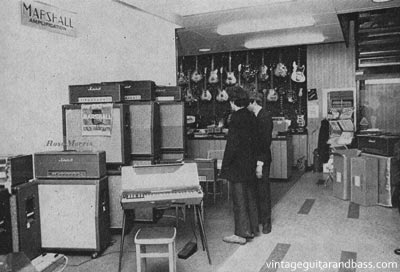 Inside the Rose-Morris store shortly after opening in late 1967. Note Hagstrom, Hofner, Fender Gibson and Rickenbacker electrics
Inside the Rose-Morris store shortly after opening in late 1967. Note Hagstrom, Hofner, Fender Gibson and Rickenbacker electrics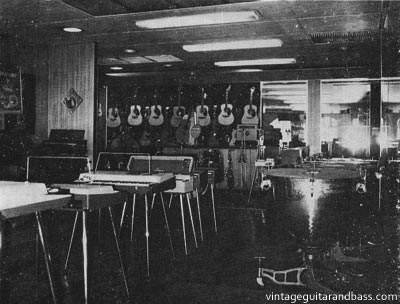
Rose Morris were Marshall distributors between 1966 and 1981, having signed a 15 year distribution deal. Marshall were clearly one of the companies best performing lines, and Rose Morris pushed Marshall heavily, placing far more adverts for amps and effects than for the other companies that they distributed. Check out further Marshall advertisements here
Rose Morris were the UK distributors for numerous guitar brands throughout the 1960s and 70s. These included high profile, high end American brands such as Rickenbacker, Ovation and Martin; mid-level brands such as Eko, Aria, Westbury, and their own brand Shaftesbury; and entry level rebranded Japanese imports Avon, and Top Twenty.
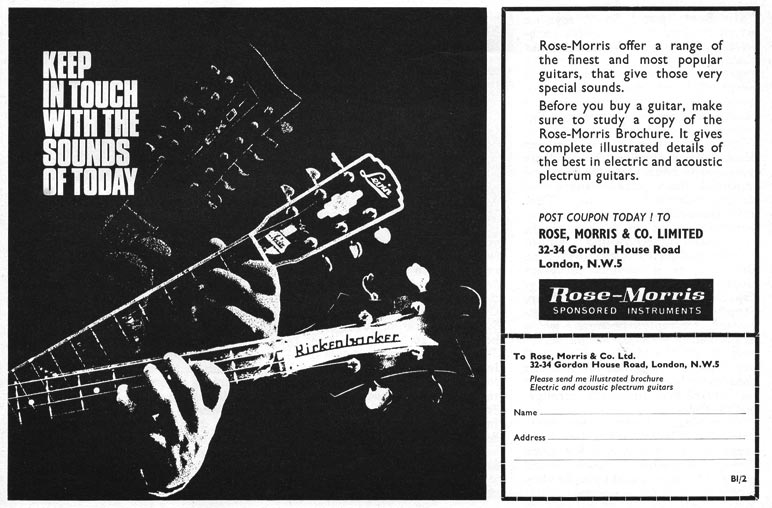
1967 advert for Rose-Morris guitars. This ad highlights some of the brands distributed at the time: Eko, Levin and Rickenbacker
Rose Morris initially applied to be the UK distributor of Rickenbacker in Summer 1962, with the first guitars shipping to the UK in January 1964. The arrangement lasted just a few years in the mid 1960s, with just a few hundred guitars and basses shipped to the UK. Rose-Morris requested a few special features, most notably f-hole sound holes, as opposed to the standard "cat's eye" slashes. These guitars were given new model codes by Rose Morris, initially: 1995 (Rickenbacker 615), 1996 (325), 1997 (330), 1998 (340) and 1999 (4001 bass). The 1993 (360/12) was added in July 1964, with two further models added in 1967, the 3261 (4005 bass) and 3262 (336/12).
Most authors suggest Rickenbacker ended the agreement in 1969, and whilst this may be officially correct, in practice, the arrangement seems to have been floundering in late 1967, around the time they opened their Shaftesbury Avenue store. A look at Rose Morris advertising through early-mid 1967 shows consistent promotion of Rickenbacker guitars and basses, even in advertisements for other products (Marshall amps) - see some of these above. From late 1967 Rickenbacker are barely mentioned by Rose Morris. Nor are they described as being present at trade fairs of the time. It is well known that Rickenbacker were failing to fill orders to Rose Morris in a timely manner; Rose Morris had even dropped the requirement for f-holes in an attempt to reduce lead times. Now, it could be that Rickenbacker simply couldn't provide sufficient stock to Rose Morris, and from their point of view, it was pointless to advertise stock that they could not provide. Rose Morris advertising in late 1967 and 1968 not only doesn't show Rickenbacker, it almost promotes their rivals. Did Rose Morris and Rickenbacker have some falling out over an order, specifically for the opening of the new Shaftesbury Avenue showroom? If so, it would make the naming of the Shaftesbury Rickenbacker copies all the more poignant!
Take a look at these two Rose Morris-placed Marshall adverts from 1967. The first shows the Jimi Hendrix Experience, Roy Orbison, the Who and the Small Faces. The second is identical, except it replaces the Who with Gary Brooker of Procul Harum and removes the Who from the text. Bear in mind that submission dates for adverts will be a month or more before the cover date, and it seems this change occurred around the time of the Shaftesbury Avenue store opening. For sure, beyond this time, Rose Morris barely mention Rickenbacker again, and certainly don't include their guitars in any advertising images.
But one other crucial piece of evidence is the launch of the new Shaftesbury guitars of Summer 1968. Many commentators suggest that Rose Morris, somewhat cheekily, launched this range whilst still distributing Rickenbacker. Reviews of the 1968 trade fair in which they were launched don't mention Rickenbacker at all. But more significantly, these guitars were allocated the same model codes as the last two Rickenbacker models, 3261 and 3262. Surely Rose Morris would not allocate these codes to Shaftesbury guitars if it expected to get more Rickenbackers with the same codes in stock.
Towards the end of 1970 "Guitar Village" (just across the road at 80 Shaftesbury Avenue) announced themselves as the new Rickenbacker main dealer.
Rose Morris were the UK distributors for Ovation instruments throughout the 1970s.
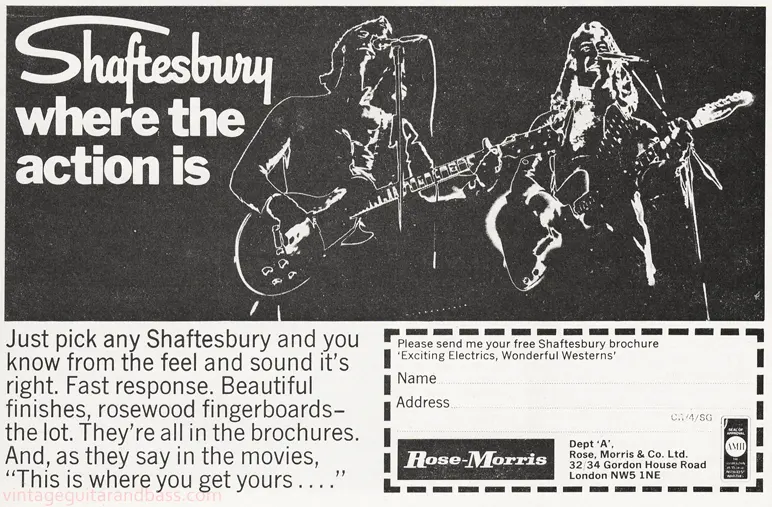
Shaftesbury advert from 1973 featuring the Shaftesbury 3400 (left) and Shaftesbury 3265 (right). "Shaftesbury where the action is".
As mentioned above, Rose-Morris opened their Shaftesbury Avenue shop in September 1967, and this location provided the name for the companies house brand of guitars, drums, effects units and amplifiers. The Shaftesbury line consisted of mid-priced electrics, well-built but not too expensive. The first Shaftesbury guitars were Japanese-built, and seeing as Rose Morris already had a relationship with Aria, these may have been made at the Matsumoku plant - though to be fair, they lack many Matsumoku characteristics of the time, so perhaps they were built elsewhere. Fujigen maybe? These were the Rickenbacker styled 3261, 3262, 3263 bass and the Gibson Barney Kessel-styled 3264. By Summer 1969, the production of these guitars had moved to Eko's plant in Italy - another company that Rose Morris distributed - with the line expanded to include a number of other copy guitars: a Thinline Telecaster copy (model 3265) and a Telecaster Bass (3266). Another model based on the Gibson Les Paul model (3400) also launched in late 1969, and this was produced in Japan by Matsumoku. Later additions included a Dan Armstrong-style perspex guitar (2402), and two British built 'Ned Callan' guitars, the Cody (3420) and Cody Bass (3421). Read about Shaftesbury guitars in more detail here.
Rose-Morris introduced the Avon line of guitars in the Summer of 1973. Whilst Shaftesbury guitars were mid-range instruments, Avon guitars were certainly entry level, typically around half the price of the Shaftesbury models. These were Japanese copies of American classics: a Les Paul, and SG, and EB0 and Jazz basses - all with basic appointments and a bolt-on neck. It is likely that these guitars were produced by the Chushin factory in Japan, and marketed through Japanese distributor Rokkomann. Very similar models were also imported by different UK distributors under the brand names Columbus, Sumbro and Saxon.
Two similar looking guitars that are often confused are the early seventies black Les Paul copies, the Shaftesbury 3400 and the Avon 3403. Even though these two guitars are very similar in looks, they are in fact very very different in construction. The Shaftesbury is a true solid body guitar, with a 4.5cm depth (at its edges). The Avon is thinner (4cm at edges), and largely (though not completely) hollow. This naturally makes for a lighter guitar. The Avon pickups are single coil, whilst the Shaftesbury are humbuckers. These factors naturally effect tone and sustain, and although neither combination is inherently superior, the Shaftesbury has more in common with the Gibson they were both copying. Finally, the Avon has chrome rather than gold-plated hardware, a pinned on plastic logo rather than an inlaid pearl one, and less binding (single ply back and neck, compared to three-ply of the Shaftesbury 3400). The Shaftesbury has a great reputation amongst Les Paul copies, as a good looking and great playing guitar. It isn't a Gibson, but it's pretty good anyway!
€7000
€500
£375
£420
£450
£350
£150
£249
£32
€8419